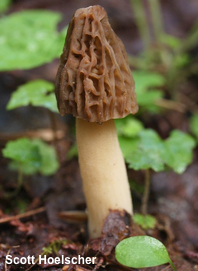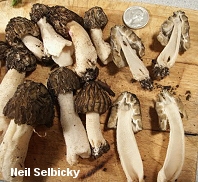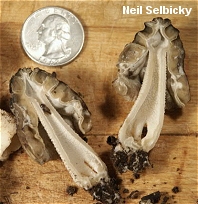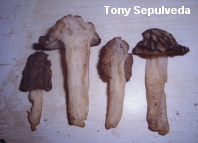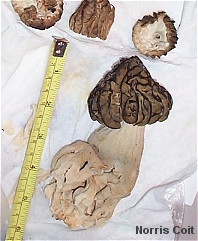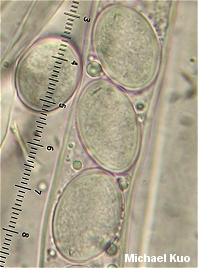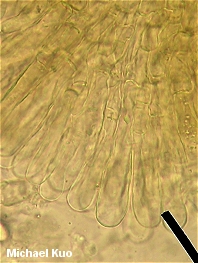| Major Groups > True Morels & Verpas > Morchella populiphila |

|
[ Ascomycetes > Pezizales > Morchellaceae > Morchella . . . ] Morchella populiphila by Michael Kuo, 1 May 2024 This is the western North American version of what we North Americans used to call "Morchella semilibera," the half-free morel—before contemporary studies (e.g. O'Donnell et al. 2011) found support for the idea that Morchella semilibera is a strictly European species, and that we have two half-free morel species on our continent: Morchella populiphila and Morchella punctipes. Half-free morels have a cap that is attached (roughly) halfway down the stem, creating a substantial overhang where the margin of the cap hangs around the stem. Verpa bohemica can look similar, but its cap hangs completely free, like a thimble sitting atop a pencil. The North American half-free morels cannot be separated by observation of their physical features, with or without a microscope, but the two known species belong to very different ecosystems, separated by a little geographic barrier known as the Rocky Mountains, making identification possible without recourse to expensive DNA testing (unless you have no idea where on this continent your half-free morel was collected, which seems unlikely). Morchella populiphila is named for its association with Populus trichocarpa, the black cottonwood of northwestern North America. Thanks to Norris Coit, Scott Hoelscher, Neil Selbicky, and Tony Sepulveda for documenting, collecting, and preserving Morchella populiphila for study; their collections are deposited in the herbarium of the Field Museum of Natural History in Chicago. Description: Ecology: Uncertain (possibly saprobic and/or mycorrhizal, or something else); growing alone, scattered, or gregariously, often under black cottonwood (Populus trichocarpa) in river bottoms; March to May; originally described from Oregon (Kuo, Carter & Moore 2012); distributed in northwestern North America, with precise distribution limits uncertain; also present in Spain "under introduced Populus cultivars originating from North America" (Richard et al. 2015), and reported without molecular support under Populus in Turkey (Azar & Uzun 2017). The illustrated and described collections are from California, Nevada, and Oregon. Cap: 2–5 cm tall and 2–5 cm wide; conic or broadly conic; attached in a skirt-like manner to the stem, about halfway from the top; pitted and ridged, with the pits primarily arranged vertically; when young with bald, flattened, honey brown to pale brownish ridges, and whitish to brownish pits; when mature developing flattened to sharpened, dark brown to black ridges and yellowish to brownish pits; hollow. Stem: 2–11 cm high and 1–5 cm wide; often hidden under the cap when young, but lengthening dramatically with maturity; fragile; in warm, wet conditions becoming inflated, especially toward the base; white to watery brownish; usually mealy with whitish granules that sometimes darken to brown; hollow. Spore Print: Yellowish orange. Microscopic Features: Spores 20–25(–29) x 12–16(–18) µm; smooth; ellipsoid; without oil droplets; with homogeneous contents. Asci 8-spored. Paraphyses cylindric with rounded, subclavate, or subacute apices; septate; hyaline in KOH. Elements on sterile ridges 100–175 x 10–25 µm; septate; tightly packed in an even layer; brownish to brown in KOH; terminal cell broadly clavate to subrectangular with a flattened to broadly rounded apex. REFERENCES: M. Kuo, M. C. Carter & J. D. Moore, in Kuo et al., 2012. (O'Donnell et al., 2011; Kuo et al., 2012; Richard et al., 2015, Azar & Uzun, 2017.) SPECIMENS EXAMINED: Herb. F. 03240401 (holotype), 04010701, 04270501, 03250601. Herb. Kuo 04251801. This site contains no information about the edibility or toxicity of mushrooms. |
© MushroomExpert.Com |
|
Cite this page as: Kuo, M. (2024, May). Morchella populiphila. Retrieved from the MushroomExpert.Com Web site: http://www.mushroomexpert.com/morchella_populiphila.html. |
